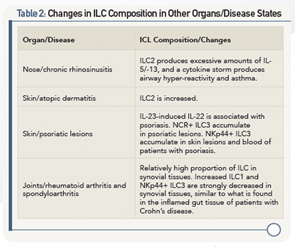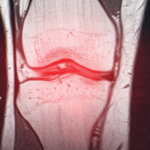Of importance is that the composition of ILCs depends on the tissue in which they are found, he said. Example: NKp44+ ILC2s are the most abundant ILCs in the ileum, and ILC2s are most abundant in the blood.
Human diseases may occur when the composition of these ILC subsets changes. Example: When looking at the gut, he said, the interaction of stromal cells and the cytokine, IL-22, provides a number of protections in the healthy gut: ILC3s derived under the influence of IL-22 protect against colitis and are critical for wound healing, and ILC3s favor growth of intestinal stem cells, and, in the mouse gut, dampen activation of pathogenic Th17 cells and, therefore, demonstrate protective immunity.
However, when the gut is inflamed, the composition of ILCs changes. Example: In patients with Crohn’s disease, ILC3s produce excessive amounts of IL-17, and ILC1s produce excessive amounts of IFNγ, both of which disturb homeostasis equilibrium and are important factors in the development of inflammation.
According to Dr. Spits, which phenotypes of human mucosal ILC develop depends on environmental cues. The plasticity of ILCs permits them to quickly switch between “harmless homeostasis and infectious states.”
Table 2 (above) lists changes in ILC composition in other organs/disease states.
“The better we understand this field, the more easily we can understand the medical literature and the therapeutics sure to arrive in the coming years,” said Dr. Sigal, adding that current research is exploring how the innate immune mechanisms may fuel the fires of chronic diseases.
Mary Beth Nierengarten is a freelance medical journalist based in St. Paul, Minn.
Key References
- Spits H, Artis D, Colonna M, et al. Innate lymphoid cells—A proposal for uniform nomenclature. Nat Rev Immunol. 2013;13(2):145–149.
- Hazenberg MD, Spits H. Human innate lymphoid cells. Blood. 2014;124(5):700–709.
- Dienfenbach A, Colonna M, Koyasu S. Development, differentiation, and diversity of innate lymphoid cells. Immunity. 2014;41(3):354–365.
- McKenzie AN, Spits H, Eberl G. Innate lymphoid cells in inflammation and immunity. Immunity. 2014;41(3):366–374.
Second Chance
If you missed this session, ACR Immunology Update: Innate Lymphoid Cells, it’s not too late. Catch it on SessionSelect: http://acr.peachnewmedia.com/store/provider/provider09.php.

